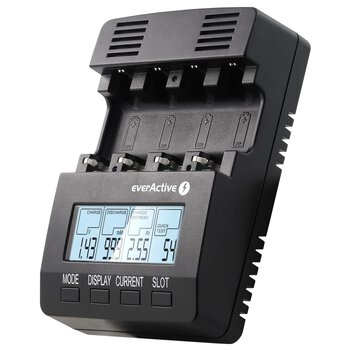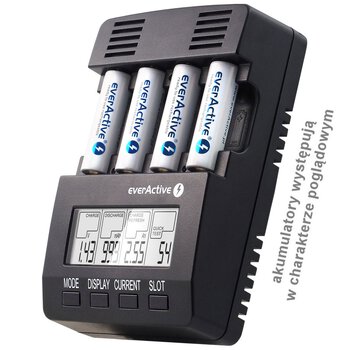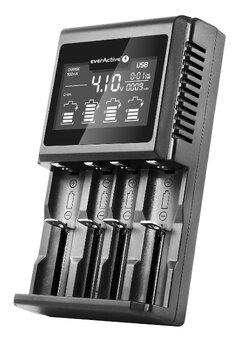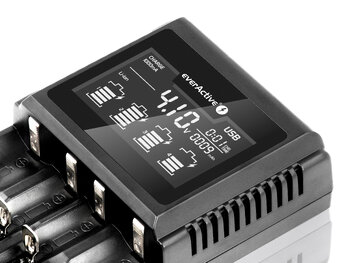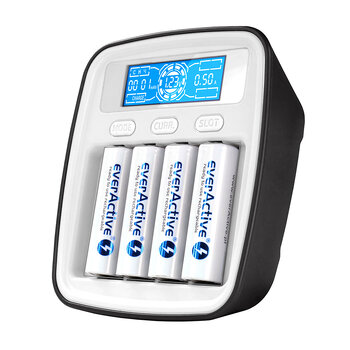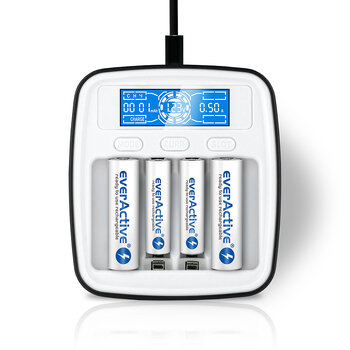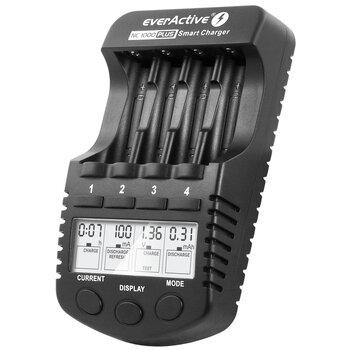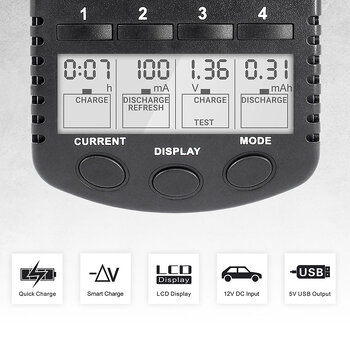- Tips
- technology
- Frequently Asked Questions
- Tests
- mAh capacity
- Rated Capacity
- everActive
- comparison
- Durability of rechargeable batteries
- Efficiency of rechargeable batteries
- battery voltage
- Accumulated energy
- Batteries vs rechargeable batteries
- LR03 AAA
- LR6 AA
- eneloop
- AG13 LR1154 LR44
- Delta V
- Charge Cycles
- internal resistance
- charge level
- CR 2032
- memory effect
- accredited test
- SR44 357
- Hearing Batteries 675
- SR626 377
- Watch Batteries
- Polarity
- Mah
- passivation
- LS 14250
- LS 14500
How to correctly measure the capacity of a 1.2V or 18650 3.7V AA battery in chargers with capacity measurement?

What is the battery capacity in mAh (milliampere-hours)?
The capacity of the battery is the most common (which does not mean that it is the best - but this is a topic for another article) parameter used to determine its performance. On its basis, we can assess how long our battery will last when it is loaded / discharged with a certain current. And so, a conventional battery with a capacity of 2000 mAh should be able to supply 2000 mA of current for 1 hour or 1000 mA of current for 2 hours, 500 mA of current for 4 hours, etc.
mA - milliampere-hours, is a unit of current/current, while h - hours, a unit of time. The mAh unit combined from these two components tells us how much current a given battery gave off (or received) in what time.
This is where the first, very common mistake made by users appears, because the mAh values returned by the charger should not always be associated with the total capacity of the battery (efficiency), declared on the battery label.
Namely, many relatively simple chargers measure the value of the mAh capacity only when charging the battery. The value measured during charging will never be a measure of the performance of the battery and we cannot directly use it to estimate the total available capacity of the battery (the value declared by the manufacturer). According to the previous explanation, in order to measure the real, true capacity of the battery, we have to discharge it - and in this case we are talking about the exact opposite process.
Each start of the charging process, regardless of the degree of charge of the battery in the charger with mAh measurement, will start counting the mAh value from zero - now, depending on how much our battery was discharged, the mAh value after a full charge may be only a small percentage of the total capacity of this battery. We interpret this value in a very simple way - the mAh result obtained during charging tells us only how much current in what time was needed for the charger to consider such a battery as full.
This often has nothing to do with its efficiency - the capacity of the battery that we can count on when it is used/discharged, and in the case of Ni-MH batteries it is not even clear in the assessment to what extent the battery was charged before it was installed in the charger and it is difficult to assess, for example, the rate of self-discharge of such a battery on this basis alone.
Why? The reason is very simple - first of all, each automatic charger must overcharge the Ni-MH 1.2V battery to some (preferably small) extent to detect its full charge. These "excessive" mAh, i.e. a value of 10% of the actual capacity of the battery (i.e. even about 250 mAh for a battery over 2500 mAh) "go into losses" and will not affect the actual result of the capacity obtained later from discharge.
This overcharging depending on the ambient temperature/temperature of the cells themselves, and even a specific battery, will sometimes be higher, sometimes smaller. In other words, it is impossible to estimate how much of the 500 mAh measured from the supercharger will later be converted into real capacity, and how much is the "loss" associated with the Ni-MH battery charging algorithm.
The result, for obvious reasons, will usually be the lowest when you try to recharge batteries that have previously been fully charged.
In the case of a charger, where the mAh measurement is only done during charging, the only way to estimate the total capacity is to completely discharge the battery first. Then the mAh value obtained during charging will be as high as possible and usually similar to the mAh capacity/efficiency value given by the manufacturer of our battery (for Ni-MH batteries on average about 10% higher). However, this information will still not be unambiguous and certain.
The Proper Method to Check the Accumulation Capacity
ploughingThe only way to actually measure the total capacity is to discharge a battery that has previously been fully charged. In other words, we need discharge capacity, not imprecise information about charging capacity.
When considering the purchase of a charger, it is worth bearing this fact in mind, as slightly more expensive models have the ability to discharge the batteries and actually measure their capacity. Examples are the everActive NC-1000 series, NC-3000 chargers for AA and AAA 1.2V batteries, or the universal UC-4000 model, which can handle both AA R6 1.2V batteries and 18650 3.7V lithium-ion batteries.
Due to the fact that the charger must completely discharge the battery, this process is quite time-consuming (it usually takes at least a few hours), but the value of the capacity that we will see at the end of such a test will be a good reference point and comparison to what the manufacturer declares.
Watch out for brand new rechargeable batteries!
In the case of a completely new AA or AAA battery, the best result will be obtained only after it is formed - which is usually after 3-5 full cycles of use.
At this point, it is worth pointing out another mistake that is made even by advanced users, and even in industry editorial offices, where batteries and rechargeable batteries are tested. As a rule of thumb, the resulting capacitance values are only comparable to each other when tested under exactly the same conditions. The values obtained with, for example, different models of chargers can and usually will differ. First of all, you can find a lot of uncertain designs on the market, which are characterized by a measurement error of even more than 20%. Unfortunately, the incorrect charging/discharging algorithms in such chargers are also nothing special.
Having the best, proven charger possible does not solve this problem at all either - even the reliable and recommended chargers from the everActive brand slightly differ from each other in terms of algorithms and test and capacity measurement conditions, so the results obtained will never be 100% identical between different models.
Each charger, regardless of its manufacturer, usually has a slightly different charging algorithm, especially in the case of 1.2V Ni-MH batteries - a slightly undercharged battery during the test will always show a slightly lower capacity than one that has been slightly overcharged beforehand. So again, it is important to make possible comparisons on the same equipment.
Contrary to appearances, the quality spreads in chargers available on the market are very large, so in the case of functions such as performance measurements, etc. I recommend using proven designs - and these undoubtedly include eneloop, everActive and Xtar chargers.
If you have any questions or doubts about the measurements and results obtained on your chargers and rechargeable batteries, let us know in the comments, we will be happy to dispel any doubts.
Author: Michał Seredziński
Copying the content of the article or its part without the consent of a representative of Baltrade sp. z o.o. is prohibited.
Recommended battery chargers with capacity test:
Charger everActive NC-3000
Processor with discharge and measurement of capacitance and a unique test of internal resistanceof the cell,
function of refresh, maintenance, battery formation,
Min. Charging time 4 batteries 2500mAh-3h.
Processor, Ni-MH, Ni-Cd, 1-4x R6/AA, R03/AAA, 1-2x R14/C, R20/D using optional adapter
12V DC Input voltage-AC adaptor included, optional car adaptor available
2 years Warranty
Charger for Li-Ion and Ni-MH rechargeable cylindrical batteries everActive UC-4000
- professional, universal microprocessor charger for Li-ion cells, Li-FePO4, Ni-MH,
- discharge and refresh function to maximize battery life,
- unique function to measure and review two capacity values for each battery after single refresh cycle - Capacity Review,
- Supported sizes: R6 AA, R03 AAA, R14 C, R20 D, 10440, 14500, 14650, 17500, 17670, 18350, 18500, 18650, 20700, 21700, 22650, 25500, 26500, 26650, 32650, 33600, 16340 R-CR123e,
- Charging current: 500 mA, 1000 mA for Li-ion/Li-FePO4, 500 mA for Ni-MH,
- very accurate and precise charging scheme regardless of battery type.
Rechargeable battery charger Ni-MH everActive NC-1000M
- modern, mobile design,
- processor with discharge and capacity measurement,
- function of refreshing, maintenance, forming batteries,
- Min. charging time of 4 batteries 2500mAh - 3h,
- processor, Ni-MH, Ni-Cd, 1-4x R6/AA, R03/AAA,
- powered from a USB Type-C socket (no power adapter included)
Ni-MH everActive NC-1000 PLUS Battery Charger
- new, improved version of the flagship model
- processor with discharge and capacity measurement,
- refresh, maintenance, battery forming,
- Min.. charging time 4 batteries 2500mAh - 3h,
- Ni-MH, Ni-Cd, 1-4x R6/AA, R03/AAA,
- 12V DC input voltage - ac adapter and car adapter included
-
Szkoda, że w artykule nie zostało powiedziane to, iż pojemność mierzona podczas rozładowywania ogniwa zależy od prądu rozładowania. Dlatego w akumulatorach kwasowo-olowiowych pojemność jest podawana najczęściej według normy C20. Są też C10, C5, C2. Różnią się one prądem rozładowania, dlatego wyniki pojemności będą zupełnie inne.
-
Tak to ważne. Ale pomimo pominięcia tej kwestii - dobry artykuł.
-
W przypadku omawianych ogniw i poruszanego w artykule zagadnienia nie jest to aż tak istotne.
Ładowarki z pomiarem pojemności dysponują co do zasady bardzo ograniczoną mocą rozładowania - prądy rozładowania są relatywnie niskie, co sprzyja osiąganiu wysokich, bliskich maksymalnym odczytom zmierzonej pojemności.
Dodatkowo akumulatory kwasowo-ołowiowe są dość specyficznym rodzajem akumulatora, gdzie rezystancja wewnętrzna akumulatora dynamicznie zmienia się w zależności od prądu ładowania/rozładowania, i tak przeciętny akumulator faktycznie osiąga często dużo niższe pojemności użytkowe przy prądach wyższych jak 0,05C.
W przypadku fabrycznie nowych ogniw Ni-MH, czy Li-ion, o których traktuje ten artykuł, o ile poruszamy się po obciążeniach dopuszczonych dla danego ogniwa to różnice w pojemnościach są dużo mniejsze - tam pojemność nominalna jest zwykle mierzona przy prądzie 0,2C (rozładowanie przez 5h), jednak nawet jak rozładujemy z obciążeniem/natężeniem 1C (w 1 godzinę) to nadal bez problemu uzyskamy 80-90% jego pojemności nominalnej podawanej dla 0,2C.
-
